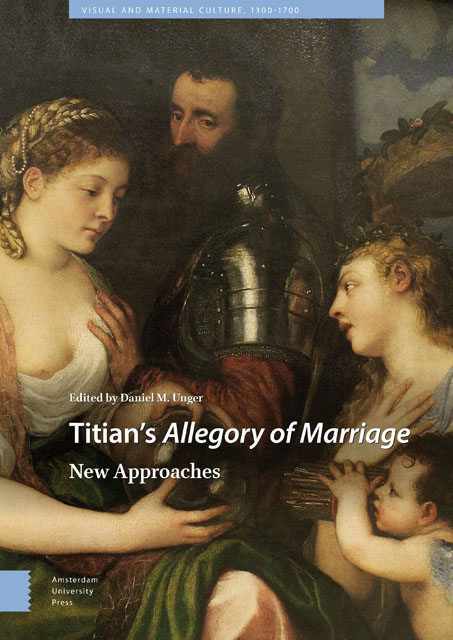Book contents
- Frontmatter
- Table of Contents
- List of Plates and Figures
- 1 Introduction: Poetic License
- 2 Love, Beauty, and the Human Body as a Reflection of the Divine
- 3 Amorosa visione: Titian’s Allegory of Marriage and the Poetry of the Half-length Format
- 4 The Arms and Armour of Titian’s Allegory of Marriage
- 5 ‘Un disio sol d’eterna gloria e fama’: A Literary Approach to Titian’s Allegory
- 6 Psyche, Venus, Ceres and Their Friends: Titian’s Remixes
- 7 Art and the Double Meaning of Reflection in Titian’s Allegory of Marriage
- 8 Titian’s Allegory of Marriage as an ‘Allegory of Peace’
- 9 Vision and Touch in the Allegory of Marriage
- 10 Of Crystal Orbs and Divinatory Mirrors : The Vicissitudes of Pregnancy and Artistic Agency in Titian’s Allegory of Marriage
- Index
9 - Vision and Touch in the Allegory of Marriage
Published online by Cambridge University Press: 16 November 2022
- Frontmatter
- Table of Contents
- List of Plates and Figures
- 1 Introduction: Poetic License
- 2 Love, Beauty, and the Human Body as a Reflection of the Divine
- 3 Amorosa visione: Titian’s Allegory of Marriage and the Poetry of the Half-length Format
- 4 The Arms and Armour of Titian’s Allegory of Marriage
- 5 ‘Un disio sol d’eterna gloria e fama’: A Literary Approach to Titian’s Allegory
- 6 Psyche, Venus, Ceres and Their Friends: Titian’s Remixes
- 7 Art and the Double Meaning of Reflection in Titian’s Allegory of Marriage
- 8 Titian’s Allegory of Marriage as an ‘Allegory of Peace’
- 9 Vision and Touch in the Allegory of Marriage
- 10 Of Crystal Orbs and Divinatory Mirrors : The Vicissitudes of Pregnancy and Artistic Agency in Titian’s Allegory of Marriage
- Index
Summary
Abstract
Titian's Allegory of Marriage depicts an equivocal moment of intimacy through a network of visual and tactile interactions. This dialectic of touch and vision evokes a range of embodied experiences that, through empathetic identification, also implicate the viewer and define a phenomenology of viewer response. Furthermore, the interplay of optical and haptic values invokes Titian's painterly practice itself, mediating between the picture as window and the brushstroke as touch. The interpretive possibilities of this dialectic culminate in the crystal sphere, a discrete object receptive to human touch that also relates abstractly to the scattering of light in space, suggesting a more radical phenomenology of intimacy that transcends the limitations of bodily Gestalt and the separation between picture and viewer alike.
Keywords: Intimacy, phenomenology, linear and painterly, the oneiric in art, viewer response
Intimacy
Vision and touch are the terms of a dialectic that lies at the foundations of modern art history, in the optical and haptic values of Riegl and the painterly/linear opposition of Wölfflin. This dialectic was also prominent in Renaissance art theory and was frequently thematized in Renaissance pictures. Few Renaissance artists explored the relationship between the tactile and the visual more movingly or elaborated its implications more eloquently than Titian, especially in his late works. The visual and tactile interactions that define the figural composition of Titian's Allegory of Marriage (Plate 1)—an interpersonal dynamic among five figures that is articulated by a circuit of expressive, receptive, withdrawn, or isolating gestures—is accompanied by a more direct appeal to the viewer in its evocation of embodied experiences and their accompanying states of mind. Attention to the interplay of vision and touch in the Allegory of Marriage provides the basis for an understanding of the painting that is attuned to its phenomenological and affective dimensions. This is a mode of interpretation distinct from iconographic or allegorical approaches, not to mention historical or contextual ones—indeed, coexistent with them, but more responsive to the work's pictorial specificity. On one level, the depiction of tactile and optical experiences in Titian's painting is a means of expressing an ambivalent moment of intimacy shared by a couple, in which those around them also participate, articulating the emotional complexity of their relationship in pictorial terms.
- Type
- Chapter
- Information
- Titian's Allegory of MarriageNew Approaches, pp. 201 - 228Publisher: Amsterdam University PressPrint publication year: 2022



